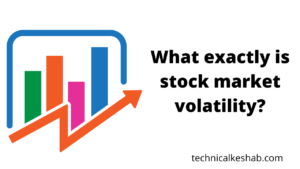It is the stock marketing where investors can trade and buy investment options — typically the stock market, which is the shares that belong to a publicly-traded company.
What is Stock Marketing?
Definition: What exactly is the stock market?
The phrase “stock market” usually means one of the main stock market indexes, such as the Dow Jones Industrial Average or the Standard and Poor’s 500.
If you buy a publicly-traded company’s stock, you’re buying just a small portion of that company. Since it’s difficult to monitor each company’s performance and performance, it’s difficult to track every company. Dow and the S&P indexes contain a portion of the stock market, and their performance is considered to be an accurate representation of the market.
The majority of stocks are purchased via the stock market, which anyone has access to using an account at a broker account or Robot-advisor.
There’s no requirement to be an “investor” to be able to invest in the stock market — for the majority of the time, and it’s available to everyone.
The stock market is regulated by the U.S. Securities and Exchange Commission, and its goal is to “protect investors, provide an orderly, fair, efficiently functioning market and to facilitate the creation of capital.”
It is possible to see the headline of a newspaper that reads it is the case that the stock market has moved lower or that it is reported that the stock market closed up or down during the day.
Usually, this means stock market indexes have moved upwards or downwards, meaning the index’s stock prices have either increased or decreased in value overall. Investors who purchase and sell stocks expect to profit from the fluctuations in the stock price.

How does the stock market work?
The idea of why works stock market works is pretty simple. A stock market let’s buyers and sellers discuss prices and also make trades.
It is believed that the stock market works through a network of exchanges. You may have heard about the New York Stock Exchange or the Nasdaq. Companies offer shares of their shares on exchanges in the process known as the Initial public offering or an IPO.
Investors buy these shares, which allow an organization to acquire funds to expand its operations. Investors then can purchase and sell the shares within themselves, while the exchange monitors the demand and supply of each stock listed.
Supply and demand determine the value of each security, as well as the prices that stock market participants — traders and investors are willing to purchase or sell.
Buyers make buyers a “bid,” or the most they’re willing to pay, which is typically less than what sellers “ask” to exchange. This difference is known as “the bid/ask spread. For a trade to occur, a buyer must raise his price, or the seller has to lower his.
It may sound like a lot of work; however, computer algorithms typically perform most price-setting calculations. When you purchase stock, you’ll find prices for the ask, bid, and bid-ask spreads on your broker’s website. However, most of the time, the difference is tiny amounts and will not cause much worry for the novice or long-term investors.
The stock market history was conducted in a market. Today, trading on the stock market works electronically, via websites and stockbrokers online. Each transaction is performed on a stock-by-stock basis; however, overall stock prices often change in line with political news, economic reports, and other things.
How is today’s stock market doing today?
Investors usually follow the performance of the market by studying the broad market indexes like those of the S&P 500 or the DJIA. The graph below illustrates how the performance is currently performing of the stock market — as determined by the S&P 500’s close price of the last trading day and the performance of the S&P 500 over the years from 1990 to the present.

The data on the stock market can be delayed by up to 20 minutes. It is only intended for informational purposes and not for trading.
What exactly is stock market volatility?
The stock market does come with risk, and however, with appropriate investment strategies, it can be done with confidence and without the chance of losing money over the long term.
Trading on the day that involves the rapid purchase and sale of stocks in response to price fluctuations is extremely risky. In contrast, making investments in the stock market for the long term is proven to be a fantastic way to accumulate wealth throughout.
For instance, for instance, the S&P 500 has a historical annualized return on average of approximately 10% before adding inflation. But, very rarely does the market give that amount on an annual basis. In certain years, it is possible that the stock market could end down dramatically, while others could go up a lot. These huge variations are caused by volatility in the market or where stock prices increase and drop unexpectedly.
If you’re constantly trading stocks and buying them, There’s a high chance that you’ll be wrong at some point, either buying or selling at the wrong moment and resulting in losses.

The most important thing to ensure your investment is safe is to remain invested throughout the ups and downs in index funds with low costs that follow the whole market, which means that your return could be similar to those of the past.
How can you make money investing in the stock market?
If you are a member of a 401(k) at your employer or other organization, you could already be investing in your stock market. Mutual funds, typically composed of stocks from several businesses, are a common feature in 401(k)s.
Individual stocks can be purchased via a brokerage account and an account for retirement, similar to an IRA. Both accounts are open with an online broker, with which you can purchase and sell investment securities. The broker is the intermediary with the stock exchanges.
In every investment, there are risks. However, stocks are riskier and offer more chances to earn rewards — than other investments. Although market growth history suggests that investing in a well-diversified portfolio of stocks will grow in value as time passes, stocks are also subject to sudden drops.

To create a diverse portfolio without purchasing a lot of individual stocks, you could invest in a mutual fund, also known as the index fund or exchange-traded fund. They aim to passively reflect how an index performs by holding every one of the investments or stocks in the index. You can, for instance, be a part of both DJIA and the S&P 500 — as in other market indexes via index funds or ETFs.
Stocks and mutual funds are excellent for long-term horizons such as retirement; however, they are not suitable for short-term investments (generally defined as funds needed to cover expenses in the next five years). When you decide to invest for a short time and a strict deadline, you’re more likely you’ll have to return the money before the market can recuperate losses.

So you are a man or woman?
MAN